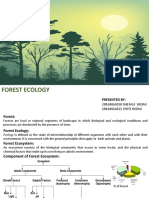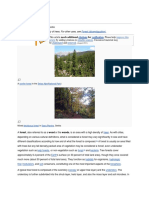0% found this document useful (0 votes)
12 views5 pagesForest
Forests are complex ecosystems dominated by trees, playing a crucial role in biodiversity, climate regulation, and providing resources. They vary in type, including boreal, deciduous, and tropical rainforests, each characterized by specific climatic and soil conditions. However, forests face significant threats from deforestation and climate change, making sustainable management essential for their preservation.
Uploaded by
Pushkar MundlikCopyright
© © All Rights Reserved
We take content rights seriously. If you suspect this is your content, claim it here.
Available Formats
Download as DOCX, PDF, TXT or read online on Scribd
0% found this document useful (0 votes)
12 views5 pagesForest
Forests are complex ecosystems dominated by trees, playing a crucial role in biodiversity, climate regulation, and providing resources. They vary in type, including boreal, deciduous, and tropical rainforests, each characterized by specific climatic and soil conditions. However, forests face significant threats from deforestation and climate change, making sustainable management essential for their preservation.
Uploaded by
Pushkar MundlikCopyright
© © All Rights Reserved
We take content rights seriously. If you suspect this is your content, claim it here.
Available Formats
Download as DOCX, PDF, TXT or read online on Scribd
/ 5





















































































